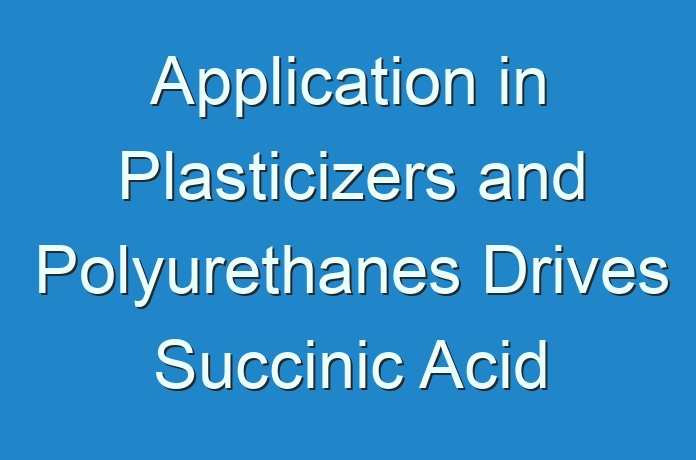
Succinic Acid Market: Introduction
In terms of value, the global succinic acid market is anticipated to expand at a CAGR of ~7% from 2019 to 2027. Succinic acid is widely used in various industries such as pharmaceuticals, chemical, and food. Currently, major proportion of succinic acid is derived from petroleum feedstock Increase in construction and infrastructure development activity is expected to trigger the demand for resin, coating, and polyurethanes, which in turn is expected to drive the growth of the market. High cost of production associated with the petroleum-based process is the major challenge facing the succinic acid market. However, the cost of production is expected to decline with the advent of bio-derived succinic acid. This is expected to propel the demand for succinic acid across the globe. Bio-based succinic acid is gaining popularity due to high degree of government intervention to reduce industrial waste and air pollutants
Application in Plasticizers and Polyurethanes Drives Succinic Acid Market
Based on application, resins, coatings, and dyes & inks segment accounted for major share of the global succinic acid market in 2018. This can be ascribed to the application of these in industries such as infrastructure and automotive, which are expanding significantly in Asia Pacific. However, plasticizers and polyurethanes expected to exhibit significant growth rate during the forecast period. Elastomers, sealants, coatings, and adhesives are major applications driving the demand for polyurethanes, whereas, Plasticizers are primarily employed as additives in the production of polyvinyl chloride (PVC) making plasticizer highly attractive application segment.
Request PDF Brochure –
https://www.transparencymarketresearch.com/sample/sample.php?flag=B&rep_id=1008
Volatility in Prices of Raw Materials Followed by Stringent Regulations May Hamper Overall Demand
Petroleum derived maleic anhydride is the conventional feedstock material used in the manufacture of succinic acid. Price of the conventionally derived succinic acid is vulnerable to any ups and down in petroleum prices. Raw material price has remained a major concern for succinic acid manufacturers. Moreover, growing environmental concern among the end users has resulted in increasing demand for green products. To overcome these restraints, succinic acid manufacturers are gradually shifting towards development and commercialization of bio-based succinic acid.
Asia Pacific Expected to be Highly Lucrative Region of Succinic acid Market
In terms of volume, Asia Pacific constituted prominent share of the global succinic acid market in 2018. It is estimated to be the fastest growing market for succinic acid owing to the increasing demand in China, India, and Japan. China has dominated the succinic acid market in Asia Pacific. Key share of the market can be ascribed to the rise in demand for polyurethanes-based products and growth in construction and automotive industries which are estimated to boost the lucrativeness of the market in Asia Pacific.
REQUEST FOR COVID19 IMPACT ANALYSIS –
https://www.transparencymarketresearch.com/sample/sample.php?flag=covid19&rep_id=1008
Succinic Acid Market – Key Industry Developments
In 2019, Royal DSM and Roquette dissolved their joint venture company Reverdia, which had been producing bio-succinic acid with trademark name Biosuccinium. Thus, Reverdia was dissolved in April 2019 and its rights were transferred to France-based Roquette. Companies has shifted their focus on production of bio-succinic acid owing to environmental constraints and awareness towards use of natural based products
Competition Landscape
The market is moderately concentrated, and the top three companies accounted for over 45% share of the global succinic acid market in 2018. Prominent players operating in the global succinic acid market are BASF SE, Anging Hexing Chemical Co.Ltd., Gadiv Petrochemical Industries Limited, BioAmber, Royal DSM, Kawasaki Kasei Chemicals, Mitsubishi Chemical Corporation, Mitsui & Co.Ltd., Myriant Technologies, Nippon Shokubai Co.Ltd, PTT Global Chemical Public Co. Ltd., and Purac Biochem.





